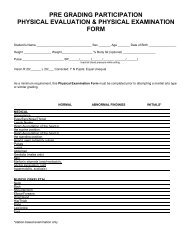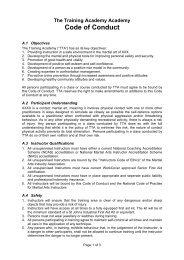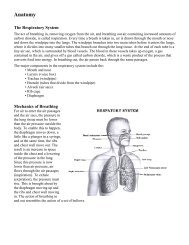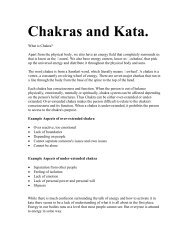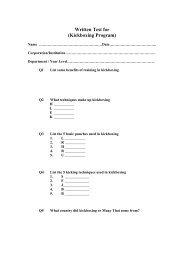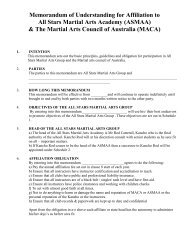Occupational violence in Disability Services code of practice (PDF
Occupational violence in Disability Services code of practice (PDF
Occupational violence in Disability Services code of practice (PDF
You also want an ePaper? Increase the reach of your titles
YUMPU automatically turns print PDFs into web optimized ePapers that Google loves.
Code <strong>of</strong> <strong>practice</strong> for the prevention and management <strong>of</strong> occupational <strong>violence</strong> <strong>in</strong> disability services 17<br />
Table 2: Risk Assessment Examples<br />
Hazardous situation<br />
1) Situations where<br />
<strong>in</strong>dividuals are<br />
bored, frustrated and<br />
dis<strong>in</strong>terested.<br />
2) Situations where the<br />
physical environment<br />
(for example house,<br />
implements) creates a<br />
potential for harm.<br />
3) Situations where the<br />
placement <strong>of</strong> <strong>in</strong>compatible<br />
<strong>in</strong>dividuals creates potential<br />
for conflict.<br />
4) Situations where<br />
<strong>in</strong>formation about <strong>in</strong>dividual<br />
needs and behaviour is not<br />
known or available to staff.<br />
5) Situations where the<br />
contribut<strong>in</strong>g factors to<br />
<strong>in</strong>dividuals’ behaviours are<br />
not well understood.<br />
6) Situations where staff<br />
are assigned without<br />
adequate support.<br />
7) Situations where the<br />
staff and people with a<br />
disability have difficulty<br />
communicat<strong>in</strong>g.<br />
8) Situations where staff<br />
work with people with a<br />
disability outside a house or<br />
facility sett<strong>in</strong>g.<br />
Risk factors<br />
• Lack <strong>of</strong> mean<strong>in</strong>gful activities that reflect <strong>in</strong>dividual’s<br />
preferences<br />
• Individual preferences not known<br />
• Individual’s whole life not considered.<br />
• No physical hazards check undertaken<br />
• Space not adequate to allow <strong>in</strong>dividuals and staff to<br />
live and work comfortably<br />
• Poorly lit spaces.<br />
• Excessive noise<br />
• No consideration <strong>of</strong> impact on other people with a<br />
disability when mix <strong>of</strong> <strong>in</strong>dividuals changed<br />
• Staff unaware <strong>of</strong> triggers.<br />
• Inadequate <strong>in</strong>formation available on new <strong>in</strong>dividuals<br />
• Inconsistent strategies used by different providers<br />
• Information about changes <strong>in</strong> <strong>in</strong>dividual’s needs or<br />
behaviour not shared by different service providers.<br />
• Lack <strong>of</strong> documented and current client medical<br />
<strong>in</strong>formation<br />
• Use <strong>of</strong> medication <strong>in</strong> a reactive rather than<br />
preventative way<br />
• Escalation because <strong>of</strong> desire to control <strong>in</strong>dividual’s<br />
behaviour rather than use judgement to defuse the<br />
situation.<br />
• Staff on first shift without appropriate brief<strong>in</strong>g on<br />
strategies to use with <strong>in</strong>dividuals<br />
• No structured process for provid<strong>in</strong>g handover<br />
<strong>in</strong>formation<br />
• Lack <strong>of</strong> tra<strong>in</strong><strong>in</strong>g <strong>in</strong> manag<strong>in</strong>g behaviours <strong>of</strong> concern.<br />
• Lack <strong>of</strong> understand<strong>in</strong>g <strong>of</strong> behaviour management<br />
strategy<br />
• Lack <strong>of</strong> documented <strong>in</strong>formation on communication<br />
strategies readily available to all staff<br />
• Staff have low self awareness <strong>of</strong> the impact <strong>of</strong> their<br />
actions or <strong>in</strong>actions on a person with a disability or<br />
the group <strong>of</strong> people liv<strong>in</strong>g <strong>in</strong> the house or unit.<br />
• Lack <strong>of</strong> support <strong>in</strong> case <strong>of</strong> emergency<br />
• Lack <strong>of</strong> visit plann<strong>in</strong>g and contact protocols<br />
• Different or unfamiliar rout<strong>in</strong>es trigger behaviours <strong>of</strong><br />
concern.







